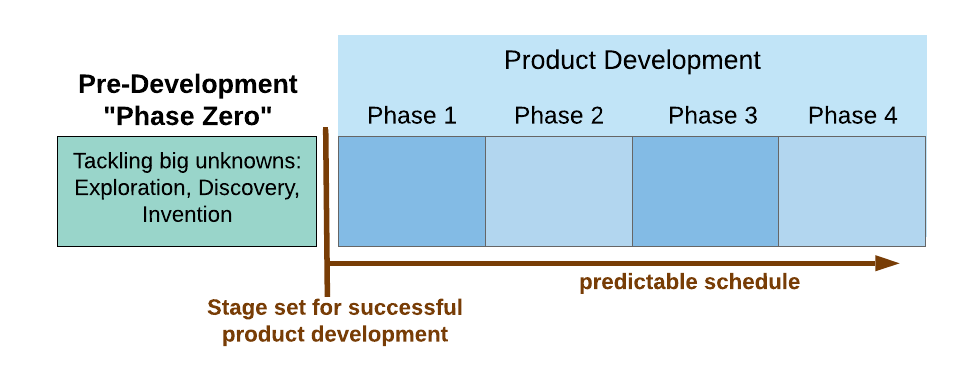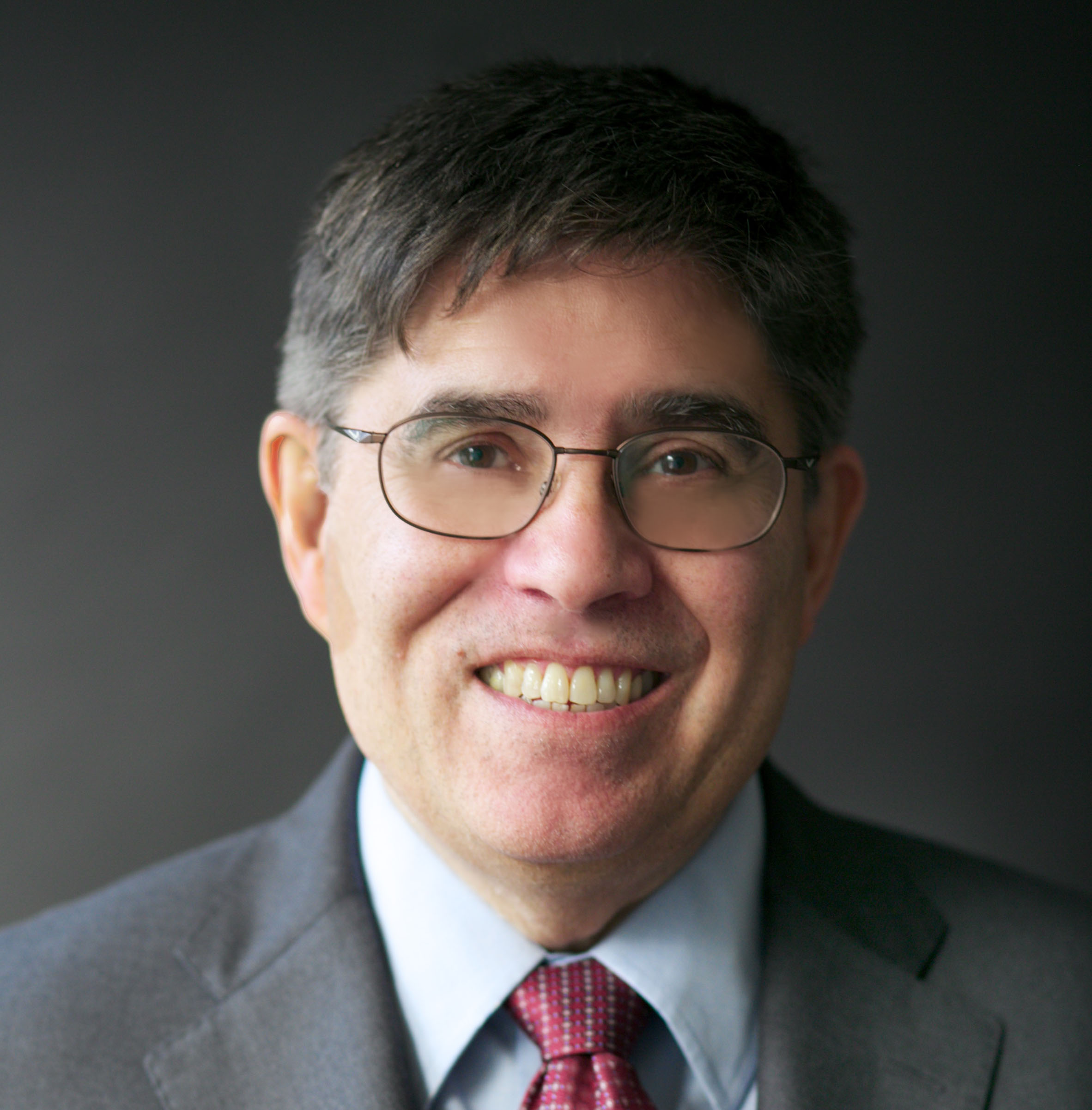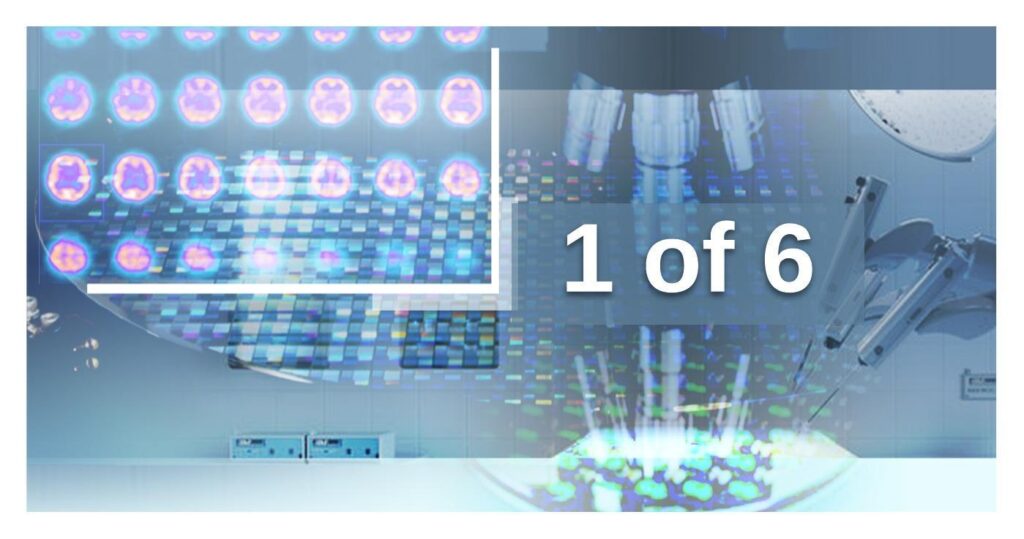Guest blog by Russ Singleton
I’ve been fortunate, living in Silicon Valley, to be able to meet and talk with Russ Singleton, a very experienced R&D executive from whom I’ve learned a lot about how to structure an organization for successful product development. For those of you who can’t meet with Russ in person, I’ve asked him to author this series of blog posts describing his experience in developing highly complex, innovative new products—from semiconductor manufacturing equipment to molecular diagnostic systems to surgical robotics. I hope you’ll enjoy these conversations with Russ as much as I have.
-Aaron Joseph
The traditional approach of marching head first into development–with Gantt charts and project planning software and fancy CAD models–does not work for complex, innovative products.
For teams developing complex products there needs to be a market definition, invention and learning phase prior to actually developing–a period of time before proceeding with “Phase 1” in the company product development process. Driving off into the sunset becomes much harder when you don’t actually know where the sun sets.
Phase Zero is your compass.
What is Phase Zero?
While the term itself may not be well known, the concept of Phase Zero has existed for decades. Fundamentally this is a safe space for focused exploration and failure (where upper management is not hovering over the team’s every move).
Practically speaking, Phase Zero enables an organization to remove the invention (i.e. reducing the discovery to proven) out of the actual development process by acting as the template for future product development.

There are many questions at the beginning of product development. The Phase Zero team should consist of key functional representatives of the questions that need to be answered. For example, a market leader and engineers who can complete the invention. If a medical device, a regulatory person to resolve what the regulatory pathway will likely be. This is a cross-functional team from different disciplines within R&D, as well as from key functions from within the rest of the company.
During Phase Zero the team is focusing on three main areas:
- Understanding what the customer wants (and what knowledge, science, technology, and logistics are needed to fulfill those expectations)
- Defining the product (why you are doing it and for whom you are doing it). What is the strategy this product will take to address the wants identified.
- Taking the science discovery> out of the development, so development doesn’t have surprises.
Understanding what the customer wants
This requires venturing into the customer habitat and talking to actual prospects. Talking to prospects requires a good scouting team capable of asking the right questions and understanding the customer’s perspective.
I’m using the word “team” to emphasize the importance of having multiple people involved. A good scouting team needs at least two people: A technologist or engineering leader and a marketing leader who understands the problem space. One of those two needs to be the “product champion”, who understands the product and is the key advocate for this product within the company. Both the engineering leader and the marketing leader need an understanding of each other’s space. That is, the engineering leader needs to “wear” half a marketing hat, and vice versa.
When talking to customers, the purpose is to understand what their problem is and what an effective solution would look like. It means you need to understand the customer’s use case very well. In medical surgery, for instance, that would mean understanding what are the surgeon’s key issues and what tools would make their job easier and the surgery more effective and how your product would fit in to do that. This could require you to build a prototype or prototypes to show.
Doing “understanding” in Action
Early in my career, I was part of an intrapreneurial “startup” in the semiconductor capital equipment business that was a major new initiative for the company to enter a new market area, to add to the portfolio of their very successful first product.
We successfully completed development of that product, created a new division and brought in a new general manager to lead this division. But then we noticed that the sales weren’t taking off the way we had hoped. To fix this, the general manager did something fairly radical–he pulled four leaders and himself out of the day-to-day responsibilities in the business to focus on this new product’s market requirements. These were leaders in marketing and engineering. I was co-inventor of the technology and head of engineering, so part of the team.
The main problem was that we really didn’t do a robust job of understanding the market requirements the first time. There was a desperate need for new marketing insight that would outline exactly what the product needed to be. We picked 20 customers in Japan and the US to contact for feedback. We sent travel scouting teams (composed of at least one engineer and one marketeer) to physically go out and visit these target customers with a kind of “straw man” in the form of a presentation of the next generation product.
What we learned was that we were doing it all wrong. And it forced us to change our whole approach to the market, and re-invent the product.
The product we had originally built was essentially a “swiss army knife” of various features and capabilities. But what we needed was a single function product that did its function extremely well, to enable the customer to do their job extremely well! The key was in defining a product based around the customer’s job, not a list of features. From there, definition, development and manufacturing of the next generation product became a more straightforward effort. When the company did introduce the next generation product, it took the industry by storm, and fundamentally changed the way the customers did their job. The company grew 10x over time, and this product market became the largest in the company.
This experience taught me that in order to ensure a predictable, successful product development process, teams need to remove the unknowns and define their product, customer, and problem extremely well before development
Summary
Phase Zero is a period of understanding your customer needs, then defining your product pathway and completing the invention, exploration, and discovery that outlines the parameters of your product. These three concepts are key to setting the stage for successful product development. In the next post I will talk about vetting new technologies and defining the right pathway.
Successful Product Development Series by Russ Singleton
This article is part of a 6 part series on success product development.
PART 1: The Secret to Product Development is to Not Start Development
PART 2: Nail your Strategy and Technology Before Development
PART 3: Forming the Right Product Development Team
PART 4: Micro Projects and Other Practices
PART 5: A Tale of Two Companies
PART 6: Post-Mortem Pre-Celebration
Further Reading
- Competing Against Luck by Clayton Christensen
- The Lean Startup by Eric Reis
Next Post: Nail your Strategy and Technology Before Development
About the Author
 Russ Singleton is a results-oriented high-growth and transformation executive with experience across MedTech, Healthcare IT, Genetic Sciences and Semiconductor Equipment sectors. He has a passion to maximize results for startups and global, mid-sized businesses. He does this by transforming culture, driving customer-focused strategy, and leading market-oriented technology innovation.
Russ Singleton is a results-oriented high-growth and transformation executive with experience across MedTech, Healthcare IT, Genetic Sciences and Semiconductor Equipment sectors. He has a passion to maximize results for startups and global, mid-sized businesses. He does this by transforming culture, driving customer-focused strategy, and leading market-oriented technology innovation.
As interim VP of R&D at Medrobotics, a surgical robotics startup, he was hired to jumpstart stalled efforts to secure CE Mark for a surgical robotics product. After successful approval, he joined full-time to lead transformation of the R&D organization. Prior to Medrobotics, Russ has extensive experience including CEO, COO, General Management and VP R&D.
Russ holds a Ph.D. and M.S. in electrical engineering from the University of Illinois and a Bachelor of Engineering from the Pratt Institute. He is also a graduate of the Management of High Technology Companies program at Stanford University’s AEA Executive Institute.
Comments from LinkedIn
Sannah Vinding
Executive Director ⇻ Innovation ⇻ Technology ⇻ Enterprise Agility ⇻ Podcast host @ Mind The Innovation ⇻ Chairman of LPPDE
“So important to address and identify the unknown, from there you can start the development”
Walt Maclay
President | Electronic Product Design Experts | Speaker Wearables, IoT, Wireless, & Medical Devices
“Exactly right. This is the most critical part of good project management – make sure you are doing the right project and it is well specified.”
Jackie Fahrner
Operations Leader (expertise Supply and Demand Management, Program Management, Business Transformation) Problem Solver, Bringing Structure to Chaos
“Phase 0 is critical for development. Launching into product development without a well understood definition (customer stories), yields a lot more work in the long run.”
Carol Kaemmerer
Executive Branding Coach | Speaker | Author. C-Suite Executives: Share your eminence 24 / 7 without opening your mouth – to increase visibility and influence, attract high-performing talent, and steer your career
“Russell M Singleton, what a powerful article. #phasezero, understanding the customers’ needs, is so essential to building the right-for-the-customer product and ensuring its success in the marketplace. Thank you for sharing this case history that illustrates this point so well.”
Kimberly Wiefling
Transformational Change Consultant & Community Builder-We Help You Diagnose & Fix What’s Proven to Damage and Destroy Organizations
“Insightful as always Russ! AND you are the kind of leader people admire and willingly follow – a DEFINITE advantage in ANY phase of product development!”
Shawn Schaerer
CEO | Autonomous Vehicles | Robotics | Perception | Safety Critical Systems
“Russell, thank you for introducing me to Phase Zero. After working with you at Medrobotics, I have successfully used it as part of my product development process.”
Ron Lichty
Software Engineering Management: Interim VP Eng, SW Dev Advisor, Agile Consultant, Author: Managing the Unmanageable
“Fascinating first post on device development and specifically medical device development!”
Edward Jaeger
Senior R&D Software Manager at Hologic – Surgical Division
“Thanks for sharing your experience, Russ.”


Pingback: Successful Product Development: A Tale of Two Companies - Sunstone Pilot, Inc.
Pingback: Forming the Right Product Development Team - Sunstone Pilot, Inc.